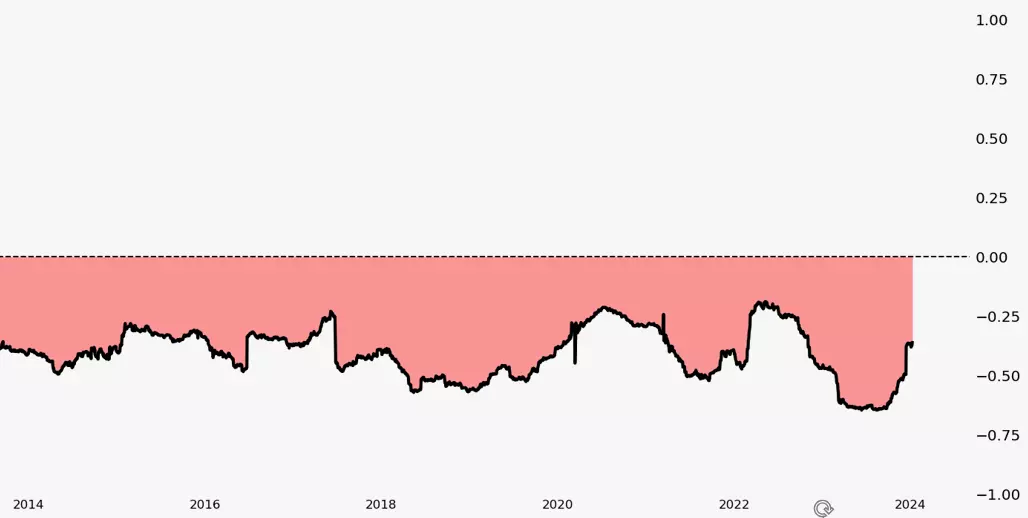Where next for USD as Gold price surges past $2,000

Key points
- Gold continues to trade above $2,000 / oz - near the top of its historic range
- US dollar is consistently negatively correlated with Gold prices
- USD/CHF shares the strongest negative correlation to Gold among USD pairs
Gold and US dollar
The link between gold (traded under symbols such as /GC on futures markets and GLD for the SPDR Gold Shares ETF) and crude oil prices to the USD is fundamental. Both commodities are primarily priced in USD, creating a natural inverse relationship with the American currency. When gold or crude oil prices rise, it often signals a weakening USD, and vice versa.
Historically, gold has been seen as a hedge against currency devaluation and inflation, effectively competing with the USD as a safe haven for investment capital. This dynamic has been more pronounced in recent times, with 2022 being a particularly strong year for USD against other major currencies, which coincided with a dip in gold prices from highs above $2,000 to below $1,700.
However, 2023 brought a bounce-back for gold, with prices returning to the $2,000 level as US dollar retreated from its peaks. This movement has provided anecdotal evidence of the negative correlation between the two. More compelling is the data from the last decade, which shows a consistently negative correlation, with recent years exhibiting some of the most significant inverse relationships between gold and the USD.
Gold - US dollar correlation

Source: dxFeed
This persistent negative correlation is noteworthy because it suggests that the movements of these two asset classes are not random but rather interconnected. For traders, this means that watching gold can offer clues about the potential direction of the USD.
The recent trend of gold maintaining prices above $2,000 might indicate a new normal for the precious metal. With gold's price remaining above this level for the longest stretch in its trading history, it raises the question of whether we are entering a period where higher gold prices become a standard expectation.
If one is bullish on gold, considering positions that are short on the USD could be advantageous. Conversely, if one expects gold prices to fall, taking a long position on the USD might be a strategic move.
Understanding the specific currency pair correlations is also crucial. USD's relationship with the Swiss Franc (CHF), for instance, shows a stark negative correlation with gold. As a result, USD/CHF is trading near its lowest since the Swiss National Bank removed the CHF's peg to the Euro in 2015.
As gold prices stabilize at higher levels, and the negative correlation with the USD persists, traders should remain vigilant, using this relationship as a barometer for potential market movements. However, it's important to remember that correlations are historical and not predictive, so they should be one of many tools used in crafting a well-rounded trading strategy.
How to trade US dollar
- Open an account to get started, or practice on a demo account
- Choose your forex trading platform
- Open, monitor, and close positions on USD pairs
Trading forex requires an account with a forex provider like tastyfx. Many traders also watch major forex pairs like EUR/USD and USD/JPY for potential opportunities based on economic events such as inflation releases or interest rate decisions. Economic events can produce more volatility for forex pairs, which can mean greater potential profits and losses as risks can increase at these times.
You can help develop your forex trading strategies using resources like tastyfx’s YouTube channel. Once your strategy is developed, you can follow the above steps to opening an account and getting started trading forex.
Your profit or loss is calculated according to your full position size. Leverage will magnify both your profits and losses. It’s important to manage your risks carefully as losses can exceed your deposit. Ensure you understand the risks and benefits associated with trading leveraged products before you start trading with them. Trade using money you’re comfortable losing.
This information has been prepared by tastyfx, a trading name of tastyfx LLC. This material does not contain a record of our trading prices, or an offer of, or solicitation for, a transaction in any financial instrument. You should not treat any opinion expressed in this material as a specific inducement to make any investment or follow any strategy, but only as an expression of opinion. This material does not consider your investment objectives, financial situation or needs and is not intended as recommendations appropriate for you. No representation or warranty is given as to the accuracy or completeness of the above information. tastyfx accepts no responsibility for any use that may be made of these comments and for any consequences that result. See our Summary Conflicts Policy, available on our website.

